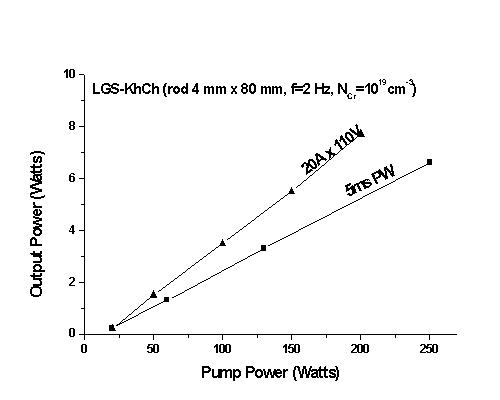| Er & Yb- glass | ||||||||||||||||||||||||||||||||||||||||||||||||||||||||||||||||||||||||||||||||||||||||||||||||||||
|---|---|---|---|---|---|---|---|---|---|---|---|---|---|---|---|---|---|---|---|---|---|---|---|---|---|---|---|---|---|---|---|---|---|---|---|---|---|---|---|---|---|---|---|---|---|---|---|---|---|---|---|---|---|---|---|---|---|---|---|---|---|---|---|---|---|---|---|---|---|---|---|---|---|---|---|---|---|---|---|---|---|---|---|---|---|---|---|---|---|---|---|---|---|---|---|---|---|---|---|---|
PROPERTIES OF IRE Erbium and Ytterbium PHOSPHATE LASER GLASSIRE RAS Er & Yb-glass characterized by a high chemical stability and excellent laser characteristics
LGS-KhM - Cr-Yb-Er-glass for uncooling miniature lasers. Ideal for eye-safe rangefinders with a high pulse repertition rate (up to 1 Hz).Depending on projected pulse repetition rate and range of working temperatures there is an opportunity of optimization of chromium ions concentration (fig.3). For example, if one has the purpose, that the output energy of a pulse in Q-switch mode was within the range of 15 mJ in the 1-st a pulse and 12 mJ in the last one in a pack from 10 pulses then the limiting repetition rate is 0,125 Hz (Eth=4.8J, η =2.5%) - for KhM/Cr5.6 (1), 0,5 Hz (Eth=5.4J, η =2.2%) - for a base chromium concentration (2) and 1 Hz (Eth=5.8J, η =2.0% ) - for KhM/Cr0.9 (3). Initial rod temperature was 20 oC
* The above-stated results are received on the IRE RAS test laser stand. Depending on a desighn, type of flashlamp and efficiency of a reflector the output can be other. LGS-KhCh (athermal Cr-Yb-Er-glass) and LGS-KhCh1(Yb-Er and Cr-Yb-Er-glass) - glass for middle and high average output power applications.
LGS-DE - Yb-Er- glass for diode-pumped lasers.Erbium diode-pumped lasers have not found now such wide application as lamp-pumped lasers. There is no a common design of such laser. Depending on the considered pump circuits it is not always possible to obtain the necessary parameters at the expense of selection of a configuration of a laser element and there is a necessity for a choice of optimum concentration of activators for each design. As an example, the fig.2 demonstrates the calculated data for a glass LGS-DE with various concentration of ytterbium ions. The model of Yb-Er system developed IRE RAS earlier was used, which takes into account such mechanisms as effect of leaving of Er ions most closely connected with neighbor Yb ions, cumulative transfer through the scheme Yb3+(2F5/2- 2F7/2) - Er3+(4I13/2 - 4F9/2) and back transfer process from erbium to ytterbium. One can see, that the efficiency of storage energy is the same in very wide range of ytterbium ions concentrations (1,5 - 4) x 1021 cm-3.
LGS-DY - Yb- glass for diode-pumped lasers.More than 40% slope efficiency output was demonstrated under 965 nm laser pump. Ytterbium borate glass is avalable. Rare-Earth-Doped Glass Fiber.Now R&D Group start investigation of fiber lasers with Yb-Er (LGS-DE) and Yb (LGS-DY) core. Activator Concentrations.Erbium glass contain optimum concentration of activators for basic types of lasers. We are ready to help you to choose glass composition for your device. We are ready also to discuss with you the requirements and to fabricate glass specially for you. Laser Roads.Er Glass is available in Laser Rods P/P/AR/AR @ 1535 nm and Road Blanks (unpolished) by sizes 1 - 10 mm (in diameter) x 1 - 150 mm (length). AR coating: Damage > 1 GW/cm2, R < 0,25%.
|


